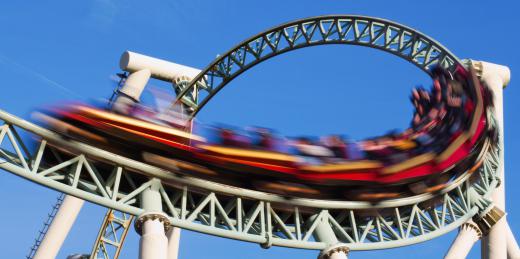How are Magnets Used in Roller Coasters?
 Tricia Christensen
Tricia Christensen
Many newer roller coasters have an unpredictable start, immediately launching off quickly, instead of making that gradual climb up a hill before sending us on a terrific series of drops and hills. This new launch style mainly uses magnets to achieve quick acceleration at the beginning of the ride.
The type of magnets used in a roller coaster may vary, but the ride depends on both the negative and positive abilities of magnets. The quick launch of a car is often due to magnetic propulsion. This relies on magnets repelling rather than attracting one another. Estimates with very strong magnets suggest such propulsion could send a ride up to 100 mph (161 kph) in a matter of seconds.

When one attempts to put magnets together that don’t attract, they push off against each other. While usual household magnets don’t have that much strength, one can still feel a push away from each magnet, almost as if they are trying to escape from each other. Combine strong magnets with a roller coaster and one develops an efficient way to launch a car forward quickly.
Additionally, a roller coaster may also rely on magnetic braking, where magnets, which attract each other gradually, slow down the car. These brakes tend to require less replacement than ordinary ride brakes, and are a cost saving as well as energy saving device.
Often, magnets on a roller coaster are controlled through automated systems. When propulsion is desired, magnets with different polarities may push down against the sides of the track to make contact with magnets with opposite polarities. When attraction is needed, magnets placed along the track gradually slow the coaster down.
The first ride to use magnetic propulsion was the Flight of Fear, in Kings Island near Cincinnati, Ohio. Other parks have quickly copied this roller coaster, completed in 1996. Millennium Force, built in 2000 at Cedar Point, a popular theme park in Sandusky, Ohio, was the first to use magnetic brakes. Magnetic braking is now so popular that it is employed on almost all newly built or designed roller coasters. Magnetic propulsion is hugely popular, and is employed on many super or hypercoasters.
AS FEATURED ON:
AS FEATURED ON:











Discussion Comments
Very helpful information.
this was really helpful. thank you!
Hello peoples, I have a question. Me and Dr. Crazy here are trying to make a model roller coaster out of a ball bearing, pipe insulators, plastic sheets and some magnets. Once we put the track together we are planning to put a negative magnet at the beginning to push away the ball bearing, then put a positive magnet on the roller coaster to attract the ball bearing, then put a negative magnet near the positive magnet to push the ball bearing away. Will any of this stuff work? Mr. Crazy and I have no clue whatsoever, though we think it is a possibility. do you think this will work?
Signed, Shnooky and Boby
You might like to mention in this article about the use of magnets on roller coasters, that sometimes an aluminum rail is vertically mounted at the end of the ride. The cars are supplied with a strong magnet which is mounted under the cars. The magnet straddles the aluminum rail causing eddy currents in the magnetic fields dramatically slowing the coaster to a safe stop.
Post your comments